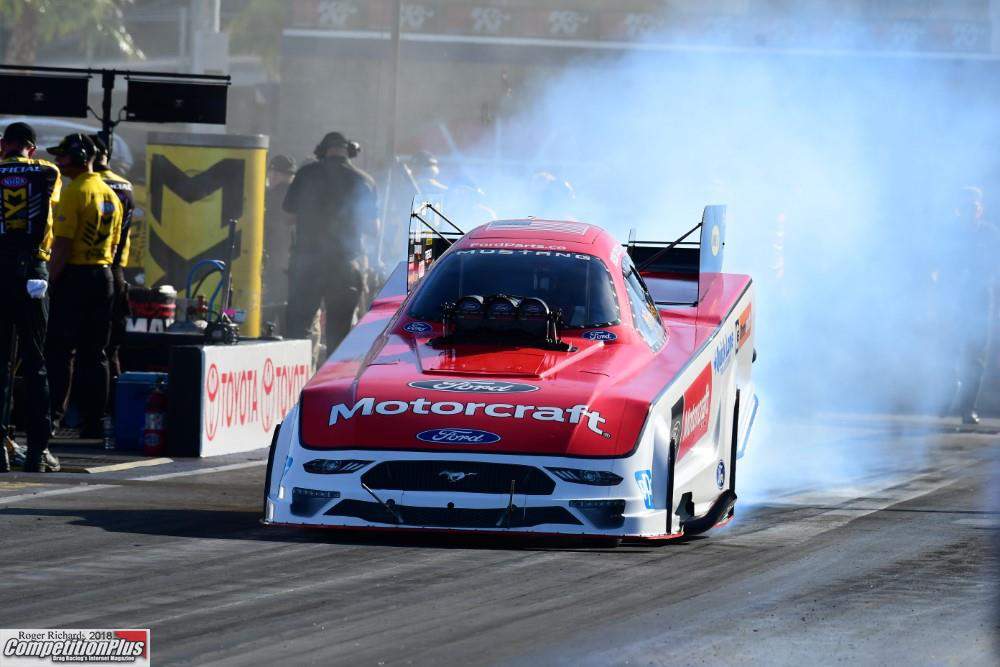TASCA TOUTS NHRA SURGE, FORD TECHNOLOGY

“The sport, no matter how you look at it, is growing. And that is almost unheard of with motorsports today. The NHRA in today’s world is as relevant as it’s ever been,” Tasca said.
“We’re in a society [of a demand for] instant information. NHRA plays to that younger generation that wants instant gratification. [In] our sport, someone wins, someone loses in three seconds. Then it happens again – and again and again and again. And you don’t have to wait two or three hours to see the final outcome. Social media-wise, it plays extremely well. Us drivers don’t especially like it, but there’s a lot of explosions, too. There’s excitement where you’re going to see a car at 300 miles per hour on fire with no brakes. It’s certainly exciting to watch, not as exciting to be in it. The sport and the access you have as a fan, you’re not sitting in a chair for two and a half or three hours. You watch a round then go to the pits. You see us tear the cars apart, down to the bar block, and back together again in under 37 minutes. And we go back and race again. The on-site experience is unlike anything you’ll ever find,” he said.
“I can brag about NHRA, but just look at the numbers,” Tasca said. “We’re up in attendance. We’re up in TV viewership. We’re up in social media. How many motorsports globally can say that?”
Tasca, who for 20 years has sat on a Ford Motor Company advisory board on which his grandfather and father also once served, was relentless in waving data in front of company decision-makers after Ford exited professional drag racing. He said their reaction to his flood of data was “We like it. We get it. But how are you going to win? That’s the only reason why we race, ultimately.”
So Tasca formed a strategic alliance with Don Schumacher Racing, one that allows him to own his own Funny Car team and work with his own marketing partners.
“Trust me – Don Schumacher wants to beat me as bad as any other car on the track. But you need a big machine behind you to build the parts and the technology. Then the next big piece of the equation we’re working on is aerodynamics. [Ford] had to jump back in with both feet to design a Funny Car body that is the slipperiest body to go down a dragstrip. And we’re in the middle of that right now,” Tasca said. “I won’t have it for this season. I’ll have it for next season.”
This current program he has, with Eric Lane managing the crew, is coming together as a competitive force after its hasty beginning.
“Literally, from the time Ford said, ‘Go’ to the time we had a team together [was] six weeks to start from scratch and get to Pomona [Calif., for the season-opener this February]. It took us probably five or six races to get our program rolling. And if you look at the last five or six races, we’re arguably one of the best cars in the country. Our program is picking up steam quickly,” Tasca said. “And that’s why Ford came back. That’s why I came back: we want to have a program this year out of the box that could run for the championship. We certainly have some more work to go. But we’re in a good position.”
And so is Ford, he said, alluding to electric and autonomous vehicles.
“It’s absolutely incredible, the technology. You talk about Apple and Microsoft, I leave these meetings with Ford, and the technology, with electric and autonomous, all the content that they’re putting into these vehicles, is mind-blowing,” Tasca said. “And I think we’re on a precipice over the next three, five, 10 years that our business is going to change. The definition of what a car looks like is going to change. What you’re going to use a car for is going to change, with autonomous technology as that unfolds. And Ford is at the forefront of this automotive revolution.”
He said Bill Ford told him that the move from today’s status quo to Ford’s new products is equivalent to the radical, groundbreaking leap from horse-and-buggy days to the automobile. “It’s a little ways out [on a timeline], but it’s not as far out as you may think.”
Tasca said he “would love to see” electrification “impact the NHRA. The electric technology that’s here and coming down the road, it’s instant torque. It would apply unbelievably well to drag racing. We need torque. We need to move the car now.”
He said electric cars will hit the dragstrip “in a very formal way with an actual class” probably sooner rather than later. “I think it’s a lot closer than some people think. I’ve driven them on Ford’s test track. It’s incredible technology. It’s fun to drive. It’s environmentally friendly. What’s really transforming is you don’t have to go to a gas station. I don’t think it’s going to replace nitro Funny Car anytime soon. I think it would be fantastic. [“Big Daddy” Don] Garlits is developing something with electric. But as electric starts to proliferate on the streets, it’s only natural that it’s going to end up on the dragstrip. I would love to dabble with it.”






































